Despite their name, snow peas can be sown and grown all year round in Australia, but there are a few special considerations to make for each season. Snow peas are a perfect crop for any Australian looking to fill that winter hunger gap in the garden, with fresh summer flavour all year round.
As we’ll look at in detail later, snow peas need cool temperatures, reasonable drainage, and some clever crop positioning. This article aims to provide a thorough guide to every aspect of growing snow peas in Australia.
More...
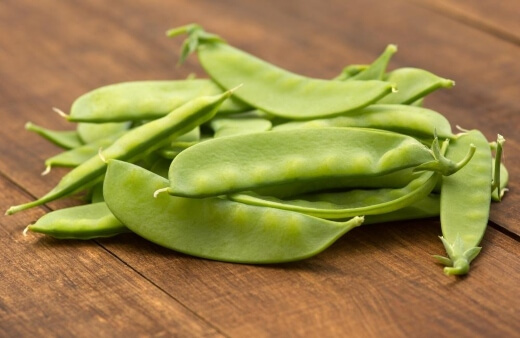
Family: | Fabaceae |
|---|---|
Genus: | Pisum |
Species: | sativum |
Common Names: | Snow pea, Mangetout, Chinese peas |
Location: | Outdoor |
Type: | Vegetable, Legume |
Growth: | 2m tall |
Sun requirements: | Sun or part-shade |
Foliage Colour: | Green |
Flower Colour: | White, Pink, Red, and/or Purple |
Flowering: | All year |
Fruit: | Edible pods and seeds |
Maintenance level: | Medium |
Poisonous for pets: | Non-toxic to cats and dogs |
What are Snow Peas?
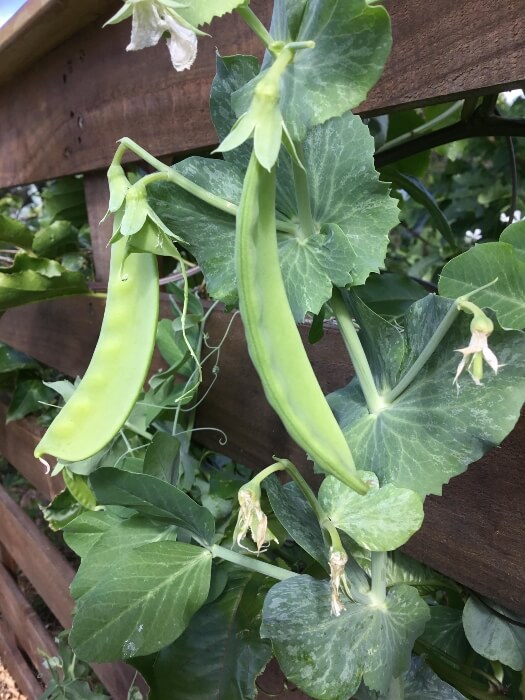
Snow peas (Pisum sativum), a common name for mangetout or Chinese peas, are vigorous crops in the Fabaceae family. Snow peas are closely related to sugar snap peas but have a rounder flavour and are more versatile in the kitchen too.
Like all peas, they have beautiful, sweetly scented flowers so are perfect to grow up trellis or teepees in your ornamental beds, offering just as much beauty as flavour.
Snow peas typically grow to around 1.5m tall on trellis or supports, but with good fertiliser and regular picking can reach 2m from an early autumn sowing.
Snow peas should be sowed regularly throughout the season to provide constant crops, which are ready to harvest after 65 days.
Snow Pea’s Natural Habitat
Snow peas have been so widely cultivated throughout the world that their origins are not generally known. They are most likely native to Thailand and Burma, but harvests have been found in excitations across the Middle East and Ethiopia that date back over 5000 years.
For the last 4000 years though, there are records of cultivated snow peas all over Europe, India and China thanks to their unfussy growing habits, and high yields.
9 Best Snow Pea Varieties to Grow in Australia
1. Green Beauty Snow PeaGreen Beauty are a simple snow pea, growing to around 150cm tall, with long green pods that are filled with plump peas after around 70-75 days, but can be eaten early as young pods after 65. Avoid direct summer sun where possible, and plant in slightly dappled light. | 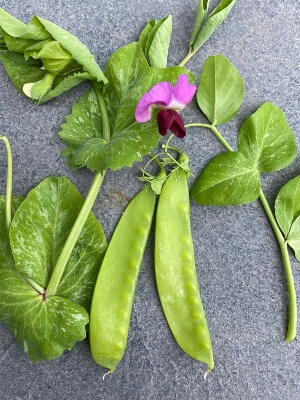 Source: wilddreamsfarm.org |
2. Avalanche Snow PeaWe’ll talk later in this article about removing tendrils to encourage more flowers and fruit, but the really lovely advantage with Avalanche is that their tendrils are delicious. The curly shoots are packed with flavour and vitamin C and can be harvested regularly from these dwarf snow peas. |  Source: capitaliron.ca |
3. Royal Snow PeaRoyal snow peas have divine purple pods, which hold their colour perfectly after cooking, making them ideal for adding colour to stir-fries. The short vines only reach about 75cm tall, so aren’t great for border displays, but they are super easy to grow in containers all year round if you can find a spot where the temperatures are around 25C for most of the day. |  Source: johnnyseeds.com |
4. Golden Sweet Snow PeaThe golden-yellow stems of Golden Sweet are lovely in their own right, but it’s the golden pods that really make this plant special. With vines reaching almost 2m tall in ideal conditions, there is something for everyone with Golden Sweet snow peas, which are beautiful when grown in obelisks in borders, or up trellis against the house. | 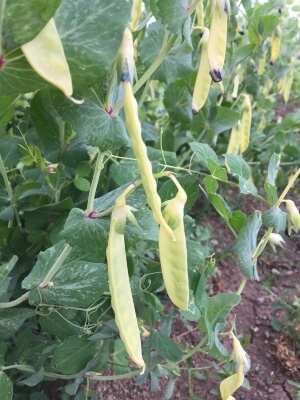 Source: highdesertseed.com |
5. Mammoth Melting Snow PeaMammoth Melting snow peas are mammoth in every way. Their vines can reach over 2m in good sun, and mild temperatures, with sweet 10cm long pods full of sweet full-bodied peas. |  Source: superseeds.com |
6. Yakumo Snow PeaYakumo snow peas are the perfect pea for passionate and dedicated gardeners. Their soft pink flowers have deep purple centres held on the end of translucent emerald green foliage. When the flowers finish, you are left with2.5m tall vines brimming with delicate, crisp pods with a beautiful sugary crunch. | 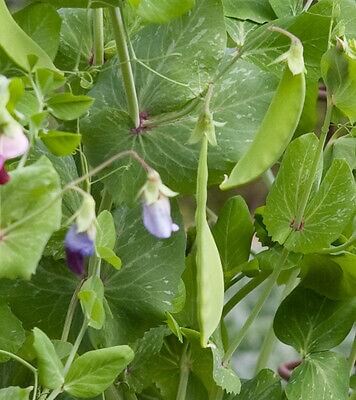 Source: ebay.com.au |
7. Oregon Sugar Pod Snow PeaFor container snow peas you can’t go wrong with Oregon Sugar Pod. This simple dwarf variety doesn’t have the bells and whistles of some snow peas, but it’s easy to grow in Australia all year round and can be eaten as young pods or plump pods later on. | 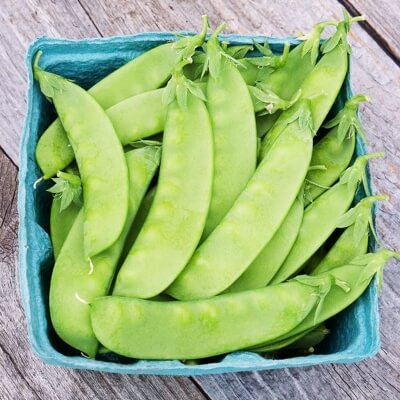 Source: highmowingseeds.com |
8. Sweet Horizon Snow PeaThe 10cm long pods of Sweet Horizon are thicker than most snow peas, with a fleshier bite that still retains some of the iconic ‘snap’ of most snow peas. While the plants themselves are nothing to write home about, with average-length vines, and plain white flowers, their peas outperform most others in the kitchen. |  Source: bolster.eu |
9. Snow Wind PeaSnow Wind is an F1 Hybrid with excellent disease resistance. They are quite hard to get hold of in Australia, but some garden centres stock them if you can’t find them online. They like full sun, but can cope with lower temperatures so are ideal for small gardens with limited growing space. |  Source: marshallsgarden.com |
9 Best Snow Pea Varieties to Grow in Australia
1. Green Beauty Snow Pea

Source: wilddreamsfarm.org
Green Beauty are a simple snow pea, growing to around 150cm tall, with long green pods that are filled with plump peas after around 70-75 days, but can be eaten early as young pods after 65. Avoid direct summer sun where possible, and plant in slightly dappled light.
2. Avalanche Snow Pea

Source: capitaliron.ca
We’ll talk later in this article about removing tendrils to encourage more flowers and fruit, but the really lovely advantage with Avalanche is that their tendrils are delicious. The curly shoots are packed with flavour and vitamin C and can be harvested regularly from these dwarf snow peas.
3. Royal Snow Pea

Source: johnnyseeds.com
Royal snow peas have divine purple pods, which hold their colour perfectly after cooking, making them ideal for adding colour to stir-fries.


Get Your Free Guide:
Master Growing Australian Natives eBook
A Must Have Complete Guide for Every Australian Garden
Get Your Free Guide:
Master Growing Australian Natives eBook
A Must Have Complete Guide for Every Australian Garden
The short vines only reach about 75cm tall, so aren’t great for border displays, but they are super easy to grow in containers all year round if you can find a spot where the temperatures are around 25C for most of the day.
4. Golden Sweet Snow Pea

Source: highdesertseed.com
The golden-yellow stems of Golden Sweet are lovely in their own right, but it’s the golden pods that really make this plant special. With vines reaching almost 2m tall in ideal conditions, there is something for everyone with Golden Sweet snow peas, which are beautiful when grown in obelisks in borders, or up trellis against the house.
5. Mammoth Melting Snow Pea

Source: superseeds.com
Mammoth Melting snow peas are mammoth in every way. Their vines can reach over 2m in good sun, and mild temperatures, with sweet 10cm long pods full of sweet full-bodied peas.
6. Yakumo Snow Pea

Source: ebay.com.au
Yakumo snow peas are the perfect pea for passionate and dedicated gardeners. Their soft pink flowers have deep purple centres held on the end of translucent emerald green foliage. When the flowers finish, you are left with2.5m tall vines brimming with delicate, crisp pods with a beautiful sugary crunch.
7. Oregon Sugar Pod Snow Pea

Source: highmowingseeds.com
For container snow peas you can’t go wrong with Oregon Sugar Pod. This simple dwarf variety doesn’t have the bells and whistles of some snow peas, but it’s easy to grow in Australia all year round and can be eaten as young pods or plump pods later on.
8. Sweet Horizon Snow Pea

Source: bolster.eu
The 10cm long pods of Sweet Horizon are thicker than most snow peas, with a fleshier bite that still retains some of the iconic ‘snap’ of most snow peas. While the plants themselves are nothing to write home about, with average-length vines, and plain white flowers, their peas outperform most others in the kitchen.
9. Snow Wind Pea

Source: marshallsgarden.com
Snow Wind is an F1 Hybrid with excellent disease resistance. They are quite hard to get hold of in Australia, but some garden centres stock them if you can’t find them online. They like full sun, but can cope with lower temperatures so are ideal for small gardens with limited growing space.
How to Grow Snow Peas in Australia
You can grow snow peas in the ground or in containers, but they need good ventilation and plenty of water in both cases. While it’s easier to manage any crop in a dedicated bed, snow peas are such beautiful plants that they are often grown as part of a display border too.
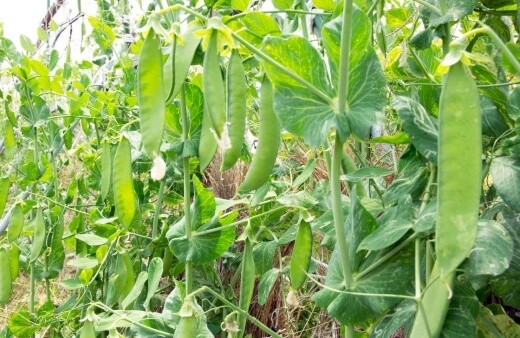
Best Soil for Snow Peas
Snow peas don’t like sitting in boggy conditions, but they also struggle through drought. For sandy soils, mix at least 50% rotted manure and/or compost into the ground to help reduce the drainage.
For clay soils, mix grit into the planting hole for drainage, and rich garden compost for nutrients. In both cases, the aim is to create fertile soil with a medium drainage speed, so you don’t have to water them every single day.
Plant Spacing
Snow peas can be grown quite tightly together, but there are some differences depending on the time of year, which we’ll look at in detail later. Sow peas or plant seedlings around 15cm apart. Snow peas are vigorous plants and they don’t like competition.
If you are planting in borders, clear at least 1 foot of ground and mix compost through the soil, removing any weeds or roots that are in that space. This gives snow peas enough space to establish a root system quickly.
Sunlight Preference
Snow peas prefer full sun in most climates, but can struggle in Australian summers. Morning and afternoon sun are ideal all year round, so find a good, bright location with some midday shade.
Temperature
The pods of snow peas curl up and become tough in winter, and plants struggle to get enough water mid-summer. Aim to keep temperatures below 30C where possible.
Watering Snow Peas
Snow peas are thirsty plants. Water as often as you can, and never let their soil dry out completely. We like to water our snow peas once every two days, with about 1L per plant. It might sound a lot, but the more water you give them, the faster and stronger they grow.
Well-watered snow peas can be covered in gorgeously scented flowers all year round if cared for properly.
What Fertiliser to Use
In theory, snow peas don’t actually need fertiliser, but in our experience, they produce far more flowers, and bigger harvests with a low dose of balanced fertiliser.
Liquid seaweed, seaweed mulches, or any basic tomato fertiliser is beneficial for snow peas. The ideal NPK to snow peas is around 5-10-10, given weekly and mixed into their water.
Snow Peas Supports
Snow peas are self-climbing so should be given trellis, bamboo, netting or tepees to grow up. Snow pea tendrils can cling onto any thin support up to around 1cm, so avoid trellis with thick timbers.
There are two ways to support snow peas:
- Allow their tendrils to clamber and grow naturally.
- Remove their tendrils regularly and tie in with twine.
But why would you remove snow pea tendrils? Well, basically, tendrils use up massive amounts of energy, and can actually reduce your crop. By pinching out snow pea tendrils and tying them in instead, you are redirecting their energy to the flowers and pods.
Growing Snow Peas in Containers
Snow peas are easy to grow in containers. Use a nice big pot, filled with compost, and push four bamboos in. Tie the bamboo at the top to create a basic tepee, and then plant one snow pea against each corner.
Water them regularly, and follow the rest of our guide for growing snow peas outdoors above.
When to Grow Snow Peas
You can sow and grow snow peas all year round in Australia, but warmer parts of the country will need to find shade in summer, while cooler regions can continue growing in full sun right through the year.
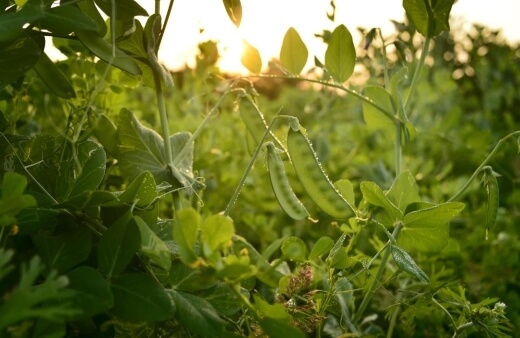
Below, we’ll look at how to grow snow peas depending on the time of year:
Growing snow peas in spring
Snow peas grow really well in spring. The wetter weather and lower morning sun helps them to cope with the rising temperatures. Aim to plant snow peas in a bright spot with a little wind to help improve airflow around the plants.
How to grow snow peas in summer
Snow peas can struggle to germinate in Australian summers, so give them good ventilation and sow them in a slightly shaded patch. While summer is their natural growing season, they don’t like temperatures above 30C, so should be planted in shade, or moved somewhere away from midday and early afternoon sun.
Summer-grown snow peas do best with around 8 hours or direct light per day, ideally in the morning and evening. If possible, plant trailing crops around their base to shade the soil, or add a mulch of fresh compost to help lock in moisture.
Growing snow peas in autumn
Autumn is the best time to sow snow peas, with falling temperatures and the welcome return of rain clouds which help improve humidity and add a little bit of shade in the afternoon. Snow peas will grow anywhere in the garden with an April-May sowing.
How to grow snow peas in winter
Snow peas can develop tough pods in winter, and while they are fairly hardy against some frost, they won’t get to their full height. Grow snow peas in full sun from June-September, and give an extra 1-20cm between each plant so light can get to every leaf.
How to Propagate Snow Pea
Snow peas are easy to germinate. Last year, we had a packet in the kitchen that got slightly damp and every seed germinated in the packet without ever being exposed to the light.

If you’d rather germinate your snow peas on purpose though, follow our guide below.
Snow Pea Propagation from Seed
You will need:
- Any garden compost (peas aren’t fussy)
- A seed tray / prepared seedbed
Method:
- Prepare your planting space. This can be indoors in a seed tray, or direct into prepared soil in the garden.
- Dig a shallow trench (max. 3cm deep) and water the bottom of the trench.
- Sow each seed 5cm apart.
- Cover the seeds, and mark each row after covering.
- Water the soil thoroughly so the surface is very damp.
- Water lightly each day if the soil starts to dry out.
- Seeds should germinate quickly, in around 5-7 days.
- As seeds germinate, thin them out so they are 15-20cm apart (you can eat the young leaves and stalks, which make great salad toppers).
Possible Snow Pea Pests and Diseases
Aside from their high risk of being eaten before you can harvest them, snow peas are easy crops to grow, but sadly, they taste just as good to insects and birds as they do to us.
In this section we’ll look at the common pests and diseases that affect snow pea plants, and how to prevent them, and treat them where appropriate.
Pigeons, Myna and other birds
Pigeons, Myna, and just about any other bird in Australia will eat snow peas when they are ready to harvest but pigeons, in particular, can be a big problem for young plants.
Pigeons and parrots are clever birds. They know what plants are high in sugars, and they know how to find them. When peas first germinate, their shoots are packed with sugars, and their young leaves are just delicious.
To avoid pigeons stripping young plants back to the stalk, net or cover your seedlings for the first few weeks. By the time plants are 1-2ft tall pigeons and Mynas won’t be a problem so you can remove the net.
Slugs and Snails
Slugs and snails are a problem with any pea plant, so remove the lower leaves once your plants reach around 1ft tall to remove the temptation.
Scatter lightly crushed egg shells at the base of each plant to discourage slugs, and if the problem persists, rub Vaseline on the lower stalks.
Aphids
Aphids, the tiny green and white flies that gather in large groups on fresh growing tips of any annual plant, are a big problem for snow peas, particularly as they are one of the few crops that can be grown all year round.
Planting nasturtiums or marigolds can help to deter them, but only works through to autumn. If the aphids are severely limiting the growth of new shoots, spray them with neem oil and then blast them off with a strong hose.
Thrips
Thrips affect the foliage and pods of snow peas, and you may notice small orange spots on either. Thrips are hard to spot, but not impossible.
If you notice black droppings on leaves or pods, it’s usually thrips, so scrape them off. The best way to fix a thrip infestation is to introduce ladybugs or carnivorous thrips, which both eat the pest type.
Heliothis caterpillars / Cutworms
Caterpillars affect spring and summer crops, but can be active all year in some parts of the country. The only real way to deal with them is to remove them by hand if you notice bites taken out of the leaves on snow peas.
Try to avoid the temptation of pesticides with caterpillars as they are an important part of the food chain, and poisoning them usually means poisoning the birds that eat them.

Downy Mildew / Powdery Mildew
Powdery mildew and downy mildew can be a problem on snow peas if you allow the foliage to get wet after a spell of dry weather. Both are airborne funguses that spread on the wind, and they can only settle on damp or humid foliage.
Leaving space between each plant helps to air out plants after rain, and reduce the likelihood of mildews.
Fusarium root rot
If you notice yellowing leaves, and your plant has the overall appearance of a dry, under-watered pea it can often be caused by fusarium, a soil borne fungus that attacks the root systems of plants.
Good drainage can reduce the chances of fusarium developing, but it is often present in the soil or compost from the previous year, and hard to get rid of.
Damping off
If you sow snow peas indoors, rather than directly into the garden they can suffer from a condition called damping-off. Essentially, poor ventilation and over-watering caused funguses or bacteria to enter the delicate young roots.
Because the roots are too young to manage their own water supply it’s really important to sow peas in well-drained compost to avoid this.
Bacterial Blight
Most gardeners are familiar with the fungal blights that affect tomatoes and potato plants, but bacterial blight is a big problem for gardeners in Australia.
Unlike fungal spores, bacteria can live in humid soil or compost for up to ten years, making it almost impossible to get rid of. If you notice brown spots, with yellow edges on your snow pea leaves, remove them immediately and burn them.
Damaged foliage allows the bacteria to enter the cells and spread, so stay on top of pest control, and protect your peas from very bad weather.
Snow Pea Frequently Asked Questions
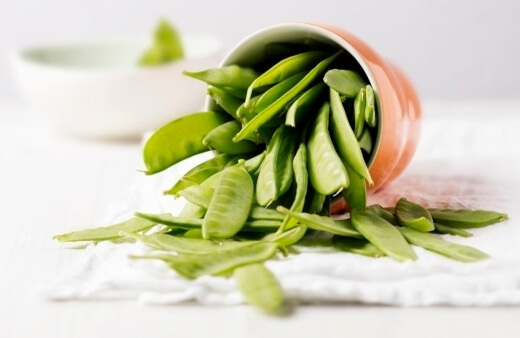
Can you eat the whole snow pea plant?
You can eat the whole snow pea plant, including stems, shoots, leaves and pods. The whole plant has a delicious sweet pea flavour, and is high in beta carotene, vitamin C and folate.
The leaves are a particularly good source of fibre too, so when your plants have finished for the year, don’t waste them, use the leaves and smaller stems in cooking.
How do you cook snow peas?
Snow peas can be eaten raw in salads or as a snack, but are traditionally used in stir-fries. The best, and easiest way to cook them to preserve their flavour is to add a very small amount of oil to an extremely hot pan, then fry them quickly until just tender.
Do snow peas need a trellis?
Snow peas need a trellis to climb through, but any support will do. Tomato cages, netting, or twine are perfectly adequate budget alternatives to traditional trellis and give you more options for planting snow peas around the garden.
Should you prefer to use a trellis, you will love our compilation of garden trellis ideas and kits for 2024.
How often should you sow snow peas?
Sow snow peas once every 2-3 weeks for continuous crops. Snow peas ripen most of their pods at the same time, so for continuous crops all year round, sow snow peas regularly.
Wrapping Up Our Snow Peas Guide
Like all peas, snow peas are thirsty plants, but quite fussy about drainage, but thanks to their prolific floral displays they are perfect for any part of the garden, making them well worth your time and effort.
Now you know how to grow snow peas, there’s nothing stopping you from planting your own today, so get out to your local garden centre and find a pack of seeds.
Snow peas are easy to sow, and can crop in just over two months, so a great instant gardening hit.
Published on August 7, 2022 by Maisie Blevins
Last Updated on September 20, 2025




